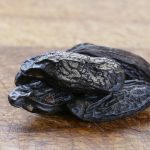
The best thing about vanilla is just how versatile it is as a flavour. Never mind the fact that it is the second most expensive spice after saffron but it is possibly the most popular flavour of all (Ranadive, 2005). It is colloquially called the ‘flavour queen’ because of its wide use in foods such as ice-cream, chocolate and confectionary generally, cigarettes, cosmetics and perfumes, and pharmaceutical products (Brunschwig et al., 2012). Of all the natural flavours this is one with extremely high aromatic flavours.
Vanilla comes from an orchid – it is the only commercially grown orchid for an ingredient as opposed to being grown for horticulture. It goes without saying that true vanilla is extremely expensive. Most of the commercially grown vanilla comes from Madagascar. The plant often gets destroyed in cyclones and the price of this rare flavour is highly variable. Indeed whilst the crop has improved after many several disastrous years of storms, the price of vanilla beans hovers around $400 to 500 per kilogram.
Unfortunately, there is not enough grown in the world, but still there is demand for the flavour. For decades, its flavour has been imitated by using a chemically derived version of vanillin.
What Are The Flavour Components?
True vanilla is made up of over 200 chemical compounds. The key flavour component is vanillin (Sinha et al., 2008) which is extracted in the flavour from the seeds of a pod of an orchid. These pods are fermented to produce true vanilla flavour. There is a good review which looks at how the flavour is produced in a variety of ways (Ramachandra Rao & Ravishankar, 2000).
Most of the world thinks vanilla ice cream is still the world’s best flavour but when it comes to its functionality, it is second to none. So many products can use it and when it is combined with other flavours it acts as a flavour enhancer or a masking agent depending on the application.
The original vanilla orchid came from Mexico and was the flat-leaved species (V. planifolia Andrews). There are 110 species of vanilla orchid but the commercial extraction is limited to V. planifolia and one called Vanilla tahitensis Moore.
Much of the world’s production is throughout the tropics in Madagascar, Indonesia, Mexico, Tahiti, Uganda, and Papua New Guinea. The orchid grown in all these countries produces similar pods but the variety of orchid is key as is the growing and curing method that affects the flavour and aroma of vanilla. Around 90% of all vanilla comes from Vanilla planifolia cv. Andrews and Vanilla tahitensis cv. Moore as the two major orchid varietals.
The extracts are regularly investigated using Gas Chromatography–Olfactometry (GC-O). Tahitian vanilla has been characterised and have a slightly spicy-anise and phenolic odour (Brunschwig et al., 2012). Most vanilla flavour develops in a form of fermentation. Green vanilla pods are generally odourless. The aroma is released by the actions of enzymes, mainly glycosidases (Odoux and Grisoni, 2010).
Production of Vanillin Using Biotechnology
The main component, vanillin (4-hydroxy-3-methoxybenzaldehyde) is the flavour compound that has received the most attention when it comes to biotechnological production. The two feedstocks are eugenol and ferulic acid. Eugenol is the main aromatic component in clove oil. It is cheap enough to make it a realistically feasible feedstock.
The main cost in the production of vanillin is product recovery as in many manufacturing processes. Technologies that have been employed include pervaporation which is the selective adsorption of a volatile solute onto a hydrophobic membrane followed by desorption into a vapour phase.
There is scope for employing metabolic engineering. The genes for the vanillin-biosynthetic pathway have been examined. Pseudomomas strains have been tested where the gene for vanillin:NAD+ oxidoreductase has been deleted. This leads to the accumulation of vanillin because it cannot be further oxidised to vanillic acid. There was a situation found with a strain HR199 where this accumulation was only partially successful. The vanillin produced became a substrate for coniferyl aldehyde dehydrogenase, an enzyme of the eugenol degradative pathway.
Products
Please note this page contains links to our affiliate marketing partner, Amazon. Please read our affiliate disclosure.
References
Brunschwig, C., Senger-Emonnot, P., Aubanel, M. L., Pierrat, A., George, G., Rochard, S., & Raharivelomanana, P. (2012). Odor-active compounds of Tahitian vanilla flavor. Food Research International, 46(1), pp. 148-157 (Article)
Burri, J., Graf, M., Lambelet, P., & Löliger, J. (1989). Vanillin: more than a flavouring agent—a potent antioxidant. Journal of the Science of Food and Agriculture, 48(1), pp. 49-56.
Odoux, E., & Grisoni, M. (Eds.). (2010). Vanilla. CRC Press.
Priefert, H., Rabenhorst, J., & Steinbüchel, A. (2001). Biotechnological production of vanillin. Applied Microbiology and Biotechnology, 56, pp. 296-314.
Ramachandra Rao, S., & Ravishankar, G. A. (2000). Vanilla flavour: production by conventional and biotechnological routes. Journal of the Science of Food and Agriculture, 80(3), pp. 289-304.
Ranadive, A.S. (2005) Vanilla cultivation. In: Vanilla: The First International Congress. Princeton : NJ : Allured, Carol Stream. p. 25–32
Sinha, A.K., Sharma, U.K., Sharma, N. (2008) A comprehensive review on vanilla flavor: extraction, isolation and quantification of vanillin and other constituents. Int. J. Food Sci. and Nutr. 59(4) pp. 299–326
Walton, N. J., Narbad, A., Faulds, C., & Williamson, G. (2000). Novel approaches to the biosynthesis of vanillin. Current Opinion in Biotechnology, 11(5), pp. 490-496


Leave a Reply